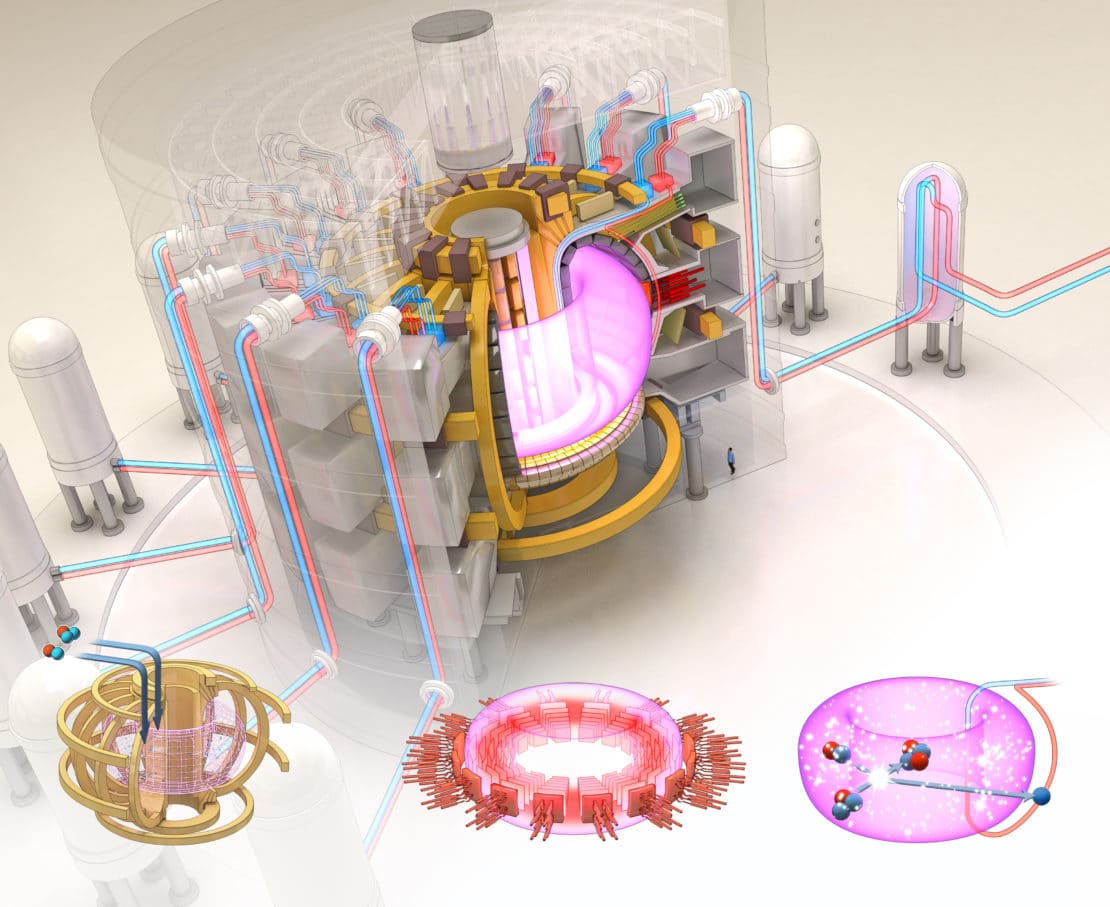
The Tokamak, which stands for “magnetic toroidal chamber” in Russian, is a machine for controlled thermonuclear fusion with a toroidal shape, similar to a doughnut. Inside we have the plasma, a very hot and rarefied gas of ions and electrons, which is suspended away from the internal walls thanks to a magnetic field. In a magnetic field, particles with an electric charge cannot move freely but are forced to follow the direction of the field itself. In the Tokamak the magnetic field closes on itself as it travels the doughnut, without ever intercepting the physical container.
In Cadarache, in the south of France , ITER is under construction, the first experimental reactor which will aim to demonstrate the feasibility of fusion energy by producing it in significant quantities. The first plasma is expected to come online in 2025.
The operating principle of a fusion power plant is similar to that of a conventional power plant: a fuel source heats the steam that drives turbines, which then activate the alternators that produce electricity.
The main difference from a power plant that uses coal or gas is in the reactor.
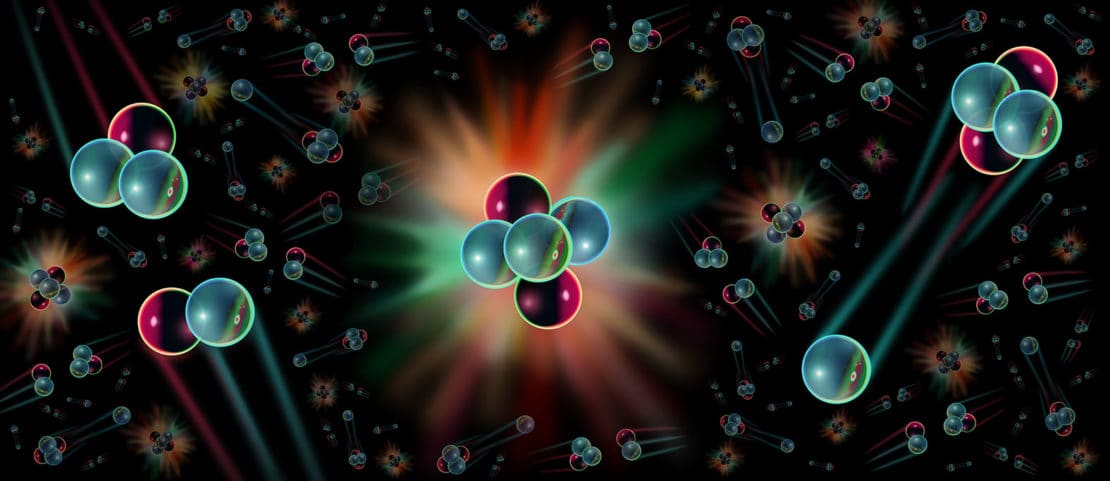
The fusion reactor exploits a process similar to that which keeps the stars and the Sun alight. Two light nuclei such as Deuterium and Tritium, both isotopes of Hydrogen, the most abundant element in the universe, collide with each other, fuse and become another harmless element: Helium. The products of the fusion have about 1% less mass than the Deuterium and Tritium input, therefore this small loss of mass is converted into a huge about of produced energy via Einstein’s famous equation E = mc2 , i.e. the amount of energy produced is equal to the mass that is lost multiplied by the speed of light squared.
The reactors will use Deuterium + Tritium (DT) as fuel, which are comparatively easier to fuse than hydrogen. Deuterium and Tritium fuse, or react, at lower energies than other light elements such as hydrogen or helium, which means we can obtain DT fusion at lower input plasma temperatures.
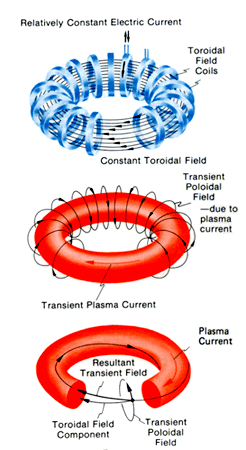
To confine the plasma in tokamak configuration, we need 3 types of magnetic fields:

Deuterium is an isotope of hydrogen commonly found in sea water. One gram of Deuterium is dissolved in about 30 liters of water. It is therefore a very common and easy to find material. Tritium, a weakly radiative element, which decays in about 12 years, does not exist in nature but can be obtained, directly inside the reactor, through Lithium. Lithium is also abundant on Earth in rocks.
Consider that our 1 g of Deuterium, when subjected to the fusion reaction, produces the same amount of energy as burning 30 metric tons of coal. From the point of view of the availability of fuel on Earth, fusion energy is practically unlimited.
The product of the fusion reaction is Helium, the light and inert gas that is used in party balloons. A fusion reactor therefore, compared to conventional power plants, does not produce CO2 or produce toxic fumes.
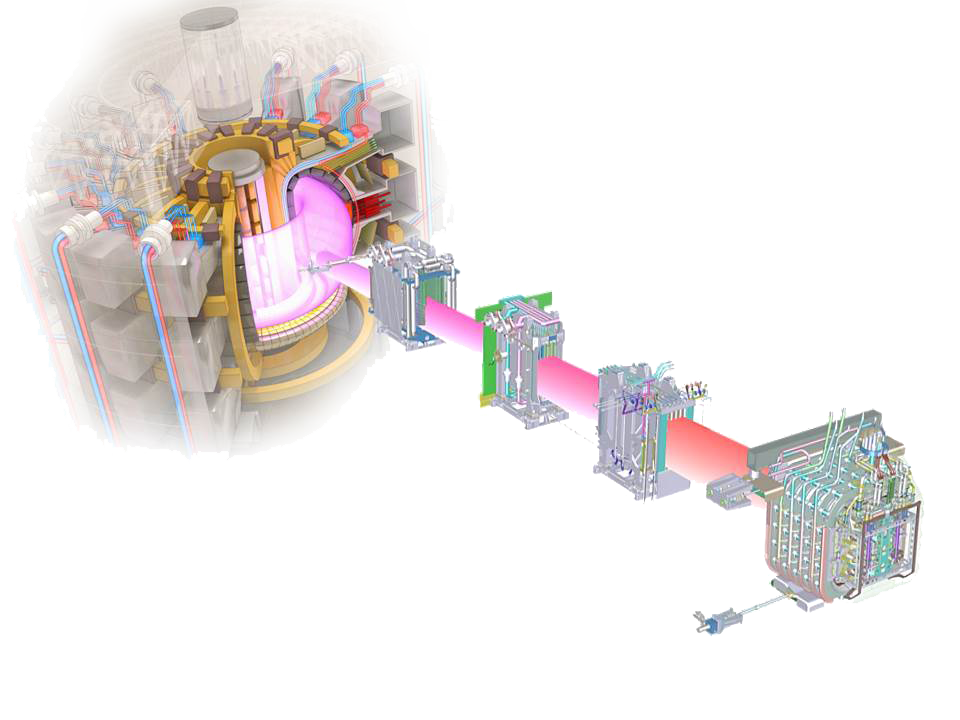
The temperature it takes for a DT fusion reaction to reliably take place on Earth is 150 million degrees, 10 times hotter than the core of the Sun. In order for Deuterium and Tritium to collide, a lot of energy must be supplied to the particles. An efficient method of imparting this energy is by ohmic heating. By letting an electric current flow through the resistive plasma, in the same principle as the metallic heating element in an electric toaster, it is possible to heat the plasma up to about 20 – 30 million degrees centigrade.
Once the plasma has formed, thanks to the heating produced by the electric current, it can be heated further with microwaves or with the injection of neutral energetic particles, using a special accelerator.
To maintain the heat of the plasma it is always necessary to apply a flow of energy. Once we have arrived at the temperature in which the fusion reactions take place, known as “ignition”, the reactions themselves produce most of the energy necessary to keep the plasma at the desired temperature. With the reactor started, therefore, only 10-30% of the energy needed to maintain the plasma temperature will have to be supplied.
The plasma also needs to conserve the energy that is supplied to it by the methods described above. To understand how good the insulation is, in plasma physics, the energy confinement time parameter is used.
If our reactor has a very long confinement time it will take little power to heat it, if the confinement time is a low value it will take a lot of energy to maintain the temperature.
In the reactor the goodness of the insulation depends on the magnetic field. Plasma is a gas composed of charged particles, the magnetic field therefore allows it to be isolated from the external environment by containing it. Since the energy contained in the plasma is essentially linked to the energy of movement of its components, if the magnetic field is strong enough, it also allows the energy, i.e. heat, to be retained inside the plasma. To do this, very intense magnetic fields are needed, but there is a limit to the intensity that can be applied. Technically, fields up to about 12 Tesla can be produced, about 200,000 times the Earth’s magnetic field.
Given a certain magnetic field, the volume of the plasma can be increased to improve the confinement time.
The plasma must also be kept in balance in a certain position. This occurs thanks to auxiliary magnetic fields that prevent the plasma from coming into contact with the reactor walls, which would lead to a sudden drop in plasma temperature and its dissapation.
It is estimated that in a future fusion reactor a toroidal volume of plasma with a minor radius of about 1 meter will be needed. The reactor will be in the tokamak magnetic configuration, with a shape similar to that of a doughnut. A very large machine equipped with all the systems to produce the magnetic field will therefore be needed. The reactor will be about 20 meters in diameter and 10 meters high, although some suggest that a system of multiple smaller reactors could have advantages, one of which is the possibility of alternating routine maintenance periods.
The reactor will have a capacity of approximately 1000 m3. A tiny amount of fuel, about half a gram, will be needed to run the reactor. For comparison there is about 10 times more matter inside an inflated balloon.
The parameters within which a Tokamak can operate are confined by a series of limits which must be taken into account when designing a fusion reactor and which ultimately represent an upper limit to the efficiency of the system.
Among the most significant:
Beyond these limits the plasma ceases to exist.
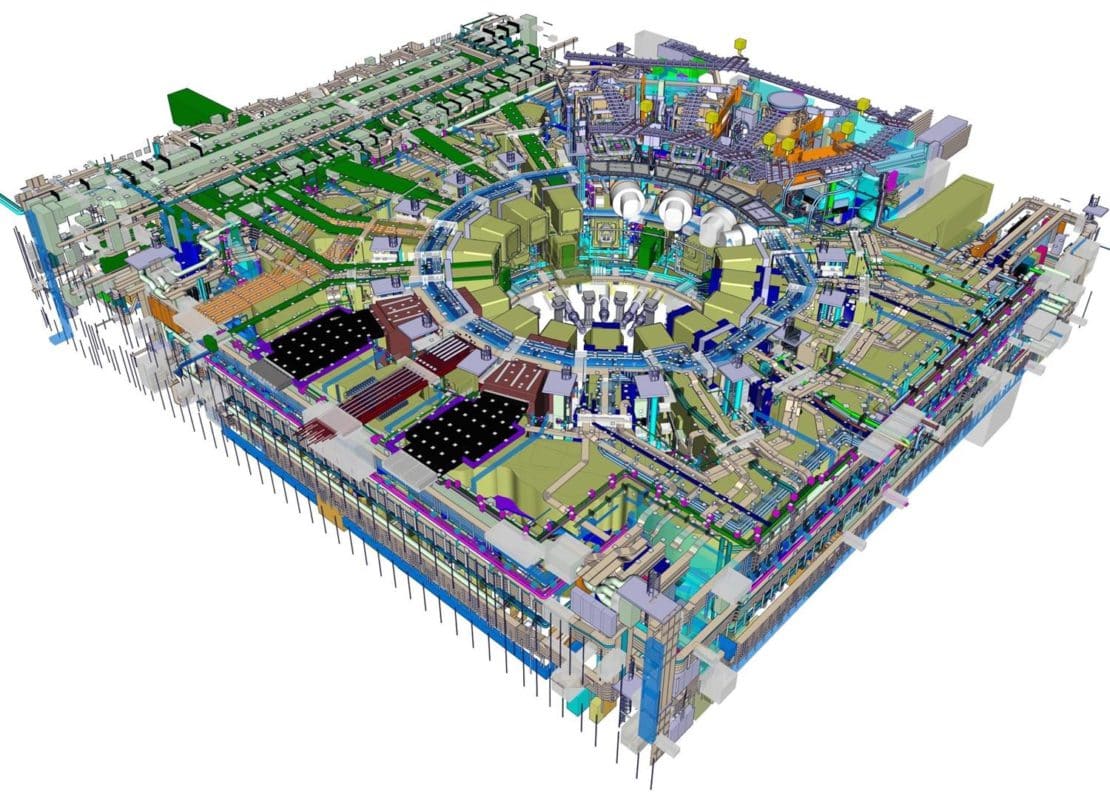
It will have a magnetic field of 5 – 6 Tesla and will run on 0.3 grams of Deuterium and Tritium. It is estimated that it will produce around 2 GW of thermal power and 500 MW of electrical power.
The coordination of fusion research in Europe is carried out by Eurofusion on behalf of the European Community which provides the economic funding.
The European program on controlled thermonuclear fusion is strongly oriented towards the construction and exploitation of the ITER experiment and the DEMO project, the prototype of the fusion reactor that will serve to demonstrate the feasibility of fusion as an energy source. An intense program of experimentation and preparation for ITER represents the effort that Eurofusion makes through the coordination of current experiments, which include different machines: ASDEX Upgrade in Germany, TCV in Switzerland, JET and MAST in England, and WEST in France. once completed, DTT in Frascati will represent the most advanced Tokamak in Europe after ITER.
Eurofusion also coordinates the activities of JT-60SA in Japan, which was jointly built by Japan and Europe.
The European research effort involves practically all aspects of physics and engineering of a fusion reactor.
Consorzio RFX has contributed and continues to contribute intensively to the Eurofusion program, both in the engineering and physical fields, with the participation in the activities of different machines, proposing and assuming the responsibility of the coordination of various experiments, as well as the coordination of some large scale projects.